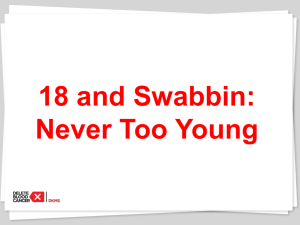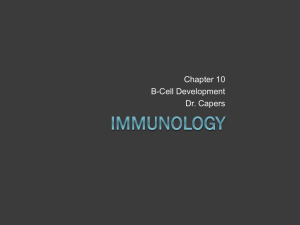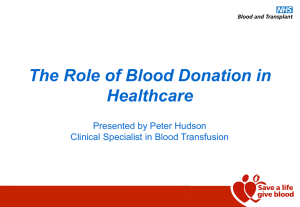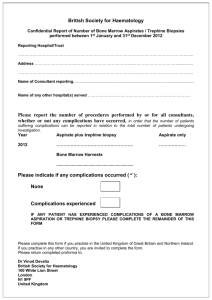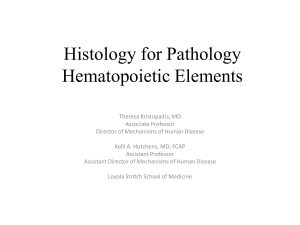informed consent for g-csf mobilized peripheral blood collection
advertisement
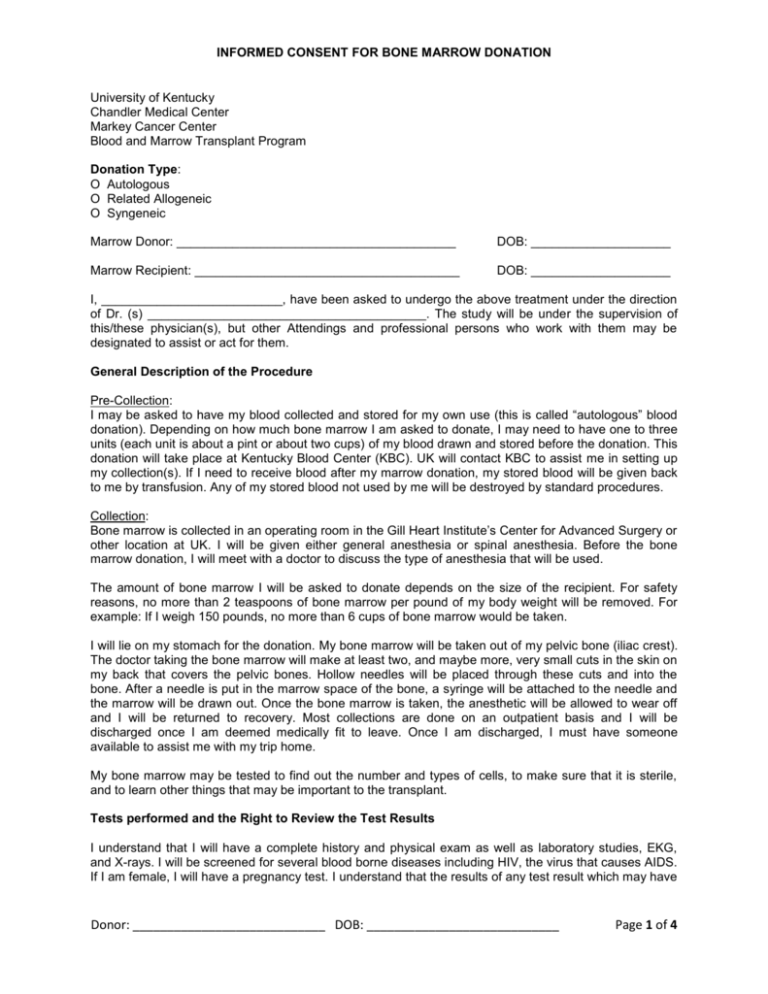
INFORMED CONSENT FOR BONE MARROW DONATION University of Kentucky Chandler Medical Center Markey Cancer Center Blood and Marrow Transplant Program Donation Type: O Autologous O Related Allogeneic O Syngeneic Marrow Donor: ________________________________________ DOB: ____________________ Marrow Recipient: ______________________________________ DOB: ____________________ I, __________________________, have been asked to undergo the above treatment under the direction of Dr. (s) ________________________________________. The study will be under the supervision of this/these physician(s), but other Attendings and professional persons who work with them may be designated to assist or act for them. General Description of the Procedure Pre-Collection: I may be asked to have my blood collected and stored for my own use (this is called “autologous” blood donation). Depending on how much bone marrow I am asked to donate, I may need to have one to three units (each unit is about a pint or about two cups) of my blood drawn and stored before the donation. This donation will take place at Kentucky Blood Center (KBC). UK will contact KBC to assist me in setting up my collection(s). If I need to receive blood after my marrow donation, my stored blood will be given back to me by transfusion. Any of my stored blood not used by me will be destroyed by standard procedures. Collection: Bone marrow is collected in an operating room in the Gill Heart Institute’s Center for Advanced Surgery or other location at UK. I will be given either general anesthesia or spinal anesthesia. Before the bone marrow donation, I will meet with a doctor to discuss the type of anesthesia that will be used. The amount of bone marrow I will be asked to donate depends on the size of the recipient. For safety reasons, no more than 2 teaspoons of bone marrow per pound of my body weight will be removed. For example: If I weigh 150 pounds, no more than 6 cups of bone marrow would be taken. I will lie on my stomach for the donation. My bone marrow will be taken out of my pelvic bone (iliac crest). The doctor taking the bone marrow will make at least two, and maybe more, very small cuts in the skin on my back that covers the pelvic bones. Hollow needles will be placed through these cuts and into the bone. After a needle is put in the marrow space of the bone, a syringe will be attached to the needle and the marrow will be drawn out. Once the bone marrow is taken, the anesthetic will be allowed to wear off and I will be returned to recovery. Most collections are done on an outpatient basis and I will be discharged once I am deemed medically fit to leave. Once I am discharged, I must have someone available to assist me with my trip home. My bone marrow may be tested to find out the number and types of cells, to make sure that it is sterile, and to learn other things that may be important to the transplant. Tests performed and the Right to Review the Test Results I understand that I will have a complete history and physical exam as well as laboratory studies, EKG, and X-rays. I will be screened for several blood borne diseases including HIV, the virus that causes AIDS. If I am female, I will have a pregnancy test. I understand that the results of any test result which may have Donor: ____________________________ DOB: ____________________________ Page 1 of 4 INFORMED CONSENT FOR BONE MARROW DONATION an implication for me will be shared with me, and I have the right to review the test results. None of these test results will be shared with anyone else without my consent. Risks There are certain risks with donating bone marrow. Serious problems from bone marrow collection are rare but could occur due to an unexpected reaction to the anesthetic or trouble with the process of taking the bone marrow. Anesthetic: For a few hours after my bone marrow has been taken, I may feel groggy and sick from the anesthetic. I will not be allowed to eat food or to get out of bed until I am wide awake and the entire anesthetic has worn off. Even after the anesthetic has worn off, I may still be sick and faint for a period of time. Possible risks with anesthetics include: High fever Allergic reaction Low blood pressure and a slowed heart rate Not able to pass urine for a brief time (spinal anesthesia) Headache (spinal anesthesia) Bone Marrow Collection: I should expect to feel some pain from the collection of the bone marrow. Most donors go through soreness in their lower back, like a back strain, that lasts for a few weeks. I may find it hard to sit in a chair for long periods of time or to climb stairs. I will most likely be less active than normal for the first two weeks after my donation. Possible risks from bone marrow collection include: Infection where the skin was cut to collect bone marrow (requires antibiotic treatment) Pain or numbness in a leg Bleeding where the skin was cut More severe pain than normal Bone, nerve or other tissue damage (requires more medical treatment or physical therapy) Life-threatening problems are extremely rare. But I should know that, as with any surgery, there is a risk of death. Caution: I should not take aspirin or aspirin-containing drugs for two weeks before my donation or for soreness after it, without the Attending physician’s permission. If you require pain medication, your physician will recommend over-the-counter medications or prescription medications as necessary. Benefits Related Allogeneic and Syngeneic Donors: There is no direct benefit that may come to me by being a donor. Autologous: The cells collected may benefit me in the course of treatment. However, there is no guarantee that the collection will be adequate to either cure or lessen the severity of my disease or condition. Alternatives to Donation Alternative to donation include: ___________________________________________________________ ____________________________________________________________________________________ Donor: ____________________________ DOB: ____________________________ Page 2 of 4 INFORMED CONSENT FOR BONE MARROW DONATION Alternative Modalities of Donation Include: _______________________________________________ ____________________________________________________________________________________ Conditions of Storage and Disposal If I am donating the cells for someone other than myself, I accept that the cells will become the property and sole responsibility of the intended recipient listed on this consent. All rights and decisions regarding the cells and their disposition will be given to that intended recipient or his/her legal representative. If the cells I am donating are to be used at the University of Kentucky, it is possible that any unused cells may be placed in frozen storage. Because of this possibility, the intended recipient of the cells will be asked to sign a “Storage Agreement for Cryopreserved Blood and Marrow Cellular Products” by UK’s Stem Cell Processing Lab. This agreement will detail the terms for the storage, transfer, and disposal of any unused cells. The intended recipient will be given a copy of this signed agreement for his/her records. After Collection I have been advised to have someone accompany me in traveling home after my marrow has been collected. After the procedure, I will be given a contact number to call if I feel ill. Authorization I authorize the collection facility medical and nursing staff to perform the marrow collection procedure. I have had the opportunity to discuss this information with _______________________. I understand the procedure and why it is being done. Any questions I might have about this procedure and its risks and consequences have been answered to my satisfaction. I may contact Dr. ______________________ at __________________________ if I have any questions regarding this procedure or if I have any unexpected or severe side effects. I will receive a copy of this consent if I wish. ___________________________________________________ Signature of Patient ____________________ Date ___________________________________________________ Signature of Parent (or legally authorized representative) ____________________ Date ___________________________________________________ Signature of Witness ____________________ Date ___________________________________________________ Signature of Investigator ____________________ Date Donor: ____________________________ DOB: ____________________________ Page 3 of 4 INFORMED CONSENT FOR BONE MARROW DONATION Attachment A DONOR TESTING Standard Blood Tests Tests are done on my blood to make sure it is safe for me to donate PBSCs or bone marrow. Any increased risk might mean that I would not be allowed to donate, or that another method of collection may be necessary. These tests also protect the recipient getting my donation. Blood Tests for Diseases My blood will be tested for infectious diseases including HIV, Hepatitis and West Nile Virus and others. If my check-up or blood test reveals anything that is not normal, I will be told. The University may be required by law to notify the state or local health agency if I test positive for Hepatitis B, Hepatitis C, or the virus that causes AIDS (HIV) or other infectious disease. Pregnancy Test If I am a woman of childbearing potential, I will be required to take a pregnancy test. I must not donate if I am pregnant. I must not take filgrastim if I am pregnant. This medication could cause serious problems for an unborn child. I must make sure that I do not get pregnant while taking filgrastim and for 48 hours after the last shot. Attachment B DEFINITIONS 1. Allogeneic donation: Donating cells for a person other than myself 2. Anesthesia: Drug or drugs designated to relieve pain and/or cause loss of consciousness 3. Blood forming cells: Cells found in the bone marrow and blood stream that rebuild my blood, bone marrow and the immune system 4. EKG: Electrocardiography (ECG or EKG) is the recording of the electrical activity of the heart over time via skin electrodes. Electrodes on different sides of the heart measure the activity of different parts of the heart muscle. It is a good way to measure and diagnose abnormal rhythms of the heart. 5. Platelets: Special blood cells that help stop bleeding by making clots. 6. Syngeneic donation: Donating cells for an identical twin 7. Syringe: Used to inject or withdraw a fluid. It has a hollow needle to break the skin and fluid is either injected into the body through the needle or fluids such as blood are withdrawn from the body. 8. Teaspoon: Equal to about 5 millimeters. There are three teaspoons in a tablespoon, 48 teaspoons in a cup. Donor: ____________________________ DOB: ____________________________ Page 4 of 4

